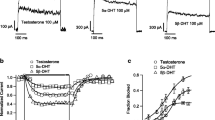Abstract
The effects of extracellular and intracellular tetraethylammonium (TEA) ions on single Ca2+-activated K+ channels were studied in excised membrane patches from the anterior pituitary clone AtT-20/D16-16 with the patch-clamp technique. The presence of TEA on either surface of the membrane resulted in a decrease in the single-channel current. Dissociation constants at zero voltage for the TEA-receptor complex were calculated to be 52.2 mM and 0.08 mM for external and internal TEA, respectively. The high sensitivity of AtT-20/D16-16 celsl to internal TEA is of considerable interest, since in other preparations, the greater TEA sensitivity for Ca2+-activated K+ channels has thus far been found to occur on the external membrane surface. Hill plot analysis of the dose-response data yielded a slope of 0.92, indicating a one-to-one stoichiometry for TEA-receptor binding. The blockade by TEA showed little voltage or current sensitivity over the membrane potential range studied, and could be fully reversed by washout in drug-free solution. The results suggest the presence of TEA receptors on both the external and internal membrane surfaces but with different binding affinities. Occupancy of either site by TEA leads to an apparent decrease in the single-channel conductance of Ca2+-activated K+ channels.
Similar content being viewed by others
References
Adams PR, Constanti A, Brown DA, Clark RB (1982) Intracellular Ca2+ activates a fast voltage-sensitive K+ current in vertebrate sympathetic neurones. Nature 296:746–749
Adler M, Wong BS, Sabol SL, Busis N, Jackson MB, Weight FF (1983) Action potentials and membrane ion channels in clonal anterior pituitary cells. Proc Natl Acad Sci USA 80:2086–2090
Armstrong CM (1975) Potassium pores of nerve and muscle membranes. In: Eisenman G (ed) Membranes: A series of advances, vol. 3. Marcel Dekker, New York, pp 325–358
Armstrong CM, Hille B (1972) The inner quaternary ammonium ion receptor in potassium channels of the node of Ranvier. J Gen Physiol 59:388–400
Armstrong CM, Taylor SR (1980) Interactions of barium ions with potassium channels in squid giant axons. Biophys J 30:473–488
Barrett JN, Magleby KL, Pallotta BS (1982) Properties of single calcium-activated potassium channels in cultured rat muscle. J Physiol 331:221–230
Benham CD, Bolton TB, Lang RJ, Takewaki T (1984) Calcium-dependent K+ channels in dispersed intestinal and arterial smooth muscle cells of guinea-pigs and rabbits studied by the patch-clamp technique. J Physiol 350:51P
Benham CD, Bolton TB, Lang KJ, Takewaki T (1985) The mechanism of action of Ba2+ and TEA on single Ca2+-activated K+ channels in arterial and intestinal smooth muscle cell membranes. Pflügers Arch 403:120–127
Blatz AL, Magleby KL (1984) Ion conductance and selectivity of single calcium-activated potassium channels in cultured rat muscle. J Gen Physiol 84:1–23
Eaton DC, Brodwick MS (1980) Effects of barium on the potassium conductance of squid axon. J Gen Physiol 75:727–750
Hamill OP, Marty A, Neher E, Sakmann B, Sigwoth FJ (1981) Improved patch-clamp techniques for high-resolution current recording from cells and cell-free membrane patches. Pflügers Arch 391:85–100
Hermann A, Gorman ALF (1981) Effects of tetraethylammonium on potassium currents in a molluscan neuron. J Gen Physiol 78:87–110
Hille B (1967) The selective inhibition of delayed potassium currents in nerve by tetraethylammonium ion. J Gen Physiol 50:1287–1302
Hille B (1984) Ionic channels of excitable membranes. Sinauer, Sutherland, Massachusetts
Iwatsuki N, Petersen OH (1985) Action of tetraethylammonium on calcium-activated potassium channels in pig pancreatic acinar cells studied by patch-clamp single-channel and whole-cell current recording. J Membr Biol 86:139–144
Koppenhöfer E (1967) Die Wirkung von Tetraäthylammoniumchlorid auf die Membranströme Ranvierscher Schnürringe vonXenopus laevis. Pflügers Arch 293:34–55
Latorre R, Miller C (1983) Conduction and selectivity in potassium channels. J Membr Biol 71:11–30
Latorre R, Vergara C, Hildago C (1982) Reconstitution in planar lipid bilayers of a Ca2+-dependent K+ channel from transverse tubule membranes isolated from rabbit skeletal muscle. Proc Natl Acad Sci USA 79:805–809
Marty A (1981) Ca-dependent K channels with large unitary conductance in chromaffin cell membranes. Nature 291:497–500
Maruyama Y, Petersen OH, Flanagan P, Pearson GT (1983) Quantification of Ca2−-activated K+ channels under hormonal control in pig pancreas acinar cells. Nature 305:228–232
Meech RW (1978) Calcium-dependent potassium activation in nervous tissues. Annu Rev Biophys Bioeng 7:1–18
Methfessel C, Boheim G (1982) The gating of single calcium-dependent potassium channels is described by an activation/blockade mechanism. Biophys Struct Mech 9:35–60
Petersen OH, Maruyama Y (1984) Calcium-activated potassium channels and their role in secretion. Nature 307:693–696
Schauf CL, Pencek TL, Davis FA (1976) Activation-inactivation coupling inMyxicola giant axons injected with tetraethylammonium. Biophys J 16:985–989
Stanfield PR (1970a) The effect of tetraethylammonium ion on the delayed currents of frog skeletal muscle. J Physiol 209:209–229
Stanfield PR (1970b) The differential effects of tetraethylammonium and zinc ions on resting conductance of frog skeletal muscle. J Physiol 209:231–256
Tasaki I, Hagiwara S (1957) Demonstration of two stable potential states in the squid giant axon under tetraethylammonium chloride. J Gen Physiol 40:859–885
Vergara C, Moczydlowski E, Latorre R (1984) Conduction, blockade and gating in a Ca2+-activated K+ channel incorporated into planar lipid bilayers. Biophys J 45:73–76
Walsh JV, Singer JJ (1983) Identification and characterization of a Ca2+-activated K+ channel in freshly dissociated vertebrate smooth muscle cells using the patch-clamp technique. Biophys J 41:56a
Wong BS, Binstock L (1980) Inhibition of potassium conductance with external tetraethylammonium ion inMyxicola giant axons. Biophys J 32:1037–1042
Wong BS, Lecar H, Adler M (1982) Single calcium-dependent potassium channels in clonal anterior pituitary cells. Biophys J 39:313–317
Woodhull AM (1973) Ionic blockade of sodium channels in nerve. J Gen Physiol 61:687–708
Yellen G (1984) Ionic permeation and blockade in Ca2+-activated K+ channels of bovine chromaffin cells. J Gen Physiol 84:157–186
Author information
Authors and Affiliations
Rights and permissions
About this article
Cite this article
Wong, B.S., Adler, M. Tetraethylammonium blockade of calcium-activated potassium channels in clonal anterior pituitary cells. Pflügers Arch. 407, 279–284 (1986). https://doi.org/10.1007/BF00585303
Received:
Accepted:
Issue Date:
DOI: https://doi.org/10.1007/BF00585303




